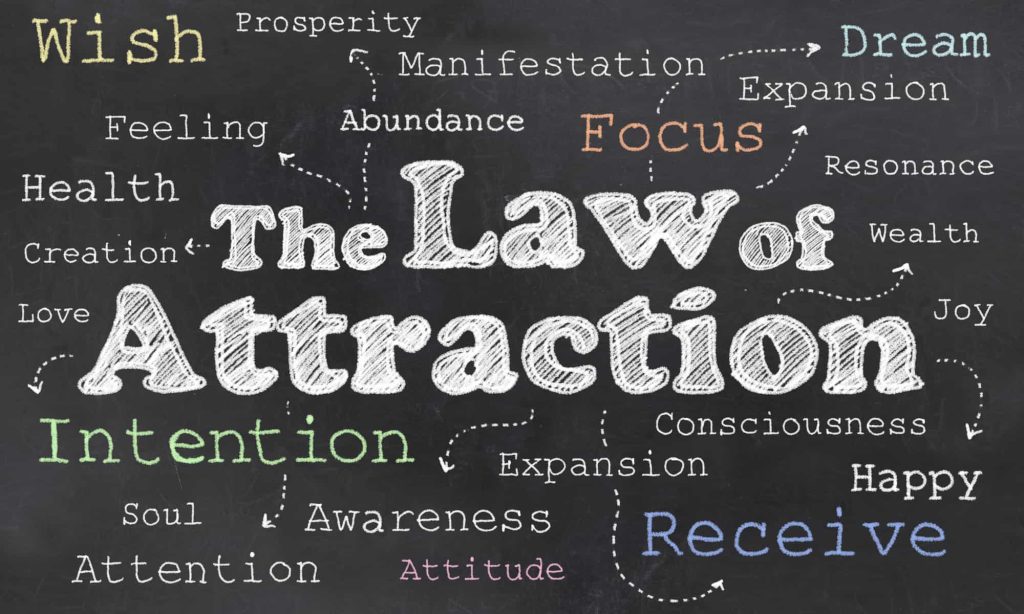The Dark Side of Positive Thinking: A Dive into the Law of Attraction

In today’s world of “silver platter” results – the expectation that we get what we want with minimal effort – the idea of “thinking positively to attract positive experiences” fits like a glove.
Prominent celebrities endorse it and countless careers have been built around teaching this philosophy. The so-called Law of Attraction (LOA) appears to have deeply embedded itself into the mainstream psyche. However, delving deeper into this seemingly innocent concept reveals a darker side.
The Law of Attraction has become one of the most popular self-help philosophies of the modern age. Promoted by best-selling books like The Secret, endorsed by celebrities, and spread through endless seminars, social media channels, and coaching programs, the idea is simple: “Think positively, and positive things will come into your life. Think negatively, and you will attract misfortune.” At face value, it sounds empowering. Who wouldn’t want the ability to manifest wealth, happiness, love, or health through sheer focus of thought? It appeals to our deepest desires for control over our lives, particularly in an uncertain world. But beneath the glossy surface, the Law of Attraction is not as innocent as it first appears. While it begins with harmless advice about optimism and goal-setting, it quickly unravels into pseudoscience, psychological traps, victim-blaming, and even dangerous health claims. This article explores the rise of the Law of Attraction, the allure that makes it so convincing, the pseudoscientific foundations it rests upon, and the toxic consequences it can have on individuals and society.
At its core, the Law of Attraction is built on a simple premise:
- Everything in the universe is energy.
- Thoughts and feelings are also energy, vibrating at specific frequencies.
- Like attracts like: positive thoughts attract positive outcomes; negative thoughts attract negative outcomes.
The comparison often used is a radio. If you “tune” your mind to the right frequency by thinking positively, you will “attract” experiences that resonate on that same frequency — whether that be wealth, success, love, or health. This claim is often framed as universal law, comparable to gravity, leaving little room for debate or skepticism. Supporters argue that we are constantly manifesting, whether we realize it or not, and that our lives are the product of the vibrations we emit. On a psychological level, this makes intuitive sense. Most people can recall moments where focusing on a goal seemed to align them with the right opportunities. But while this is better explained by focus, discipline, and coincidence, the Law of Attraction turns it into a mystical system where the universe itself is said to deliver results.
The Allure and Deception of The Law of Attraction
The concept of positive thinking holds a special allure. Who wouldn’t be captivated by the promise that by simply changing your thoughts and feelings, you could materially change your life circumstances? Visualising your ambitions, having set goals, practising affirmations, and meditating all sound promising and are not inherently dangerous. The danger lies not in the practices themselves, but in the commercialised and distorted interpretations like the Law of Attraction that imbue them with pseudo-spirituality.
The Law of Attraction thrives because it appeals to human emotion, desire, and hope. There are several reasons why it’s so seductive:
- It Offers Control in an Uncontrollable World: Life is unpredictable, filled with setbacks and uncertainty. The Law of Attraction tells people they can take control of their destiny simply by changing their thoughts. This can feel empowering in times of stress or despair.
- It Feels Optimistic and Uplifting: Positive affirmations, visualization, and goal-setting are already proven to improve motivation and confidence. The Law of Attraction simply amplifies these practices with a spiritual twist, making them feel more profound.
- It’s Backed by Celebrity Endorsements: Oprah Winfrey, Jim Carrey, Conor McGregor, and Will Smith are just a few of the big names who have publicly credited the Law of Attraction for their success. When admired figures promote it, millions of people take notice.
- It’s Simple: Unlike complex psychological theories or long-term behavior change, the Law of Attraction presents an easy formula: think it, feel it, attract it. No technical skills, no years of training, just belief.
- It Sells Hope: At its heart, it markets the idea that anyone — regardless of circumstance — can become wealthy, healthy, or successful. For people struggling financially, emotionally, or socially, that hope can be irresistible.
The combination of simplicity, positivity, and marketability has made the Law of Attraction a billion-dollar industry. But its very appeal is also its greatest danger.
The Profitable World of Pseudoscience
Despite how one may personally feel about the LOA, there’s no denying its widespread popularity. But beneath the appealing facade lies a mire of pseudoscience and misconceptions. Take, for instance, the often-cited Einstein quote about matching the frequency of the reality one desires. This quote, however frequently used by LOA proponents, was never actually spoken by Einstein.
At its foundation, the LOA is classified as pseudoscience by the scientific community because it lacks any empirical evidence to support its claims. Proponents often rely on anecdotal stories and self-reported successes, but these are not verifiable through controlled experiments or peer-reviewed research. For instance, there are no rigorous studies demonstrating that thoughts alone can “attract” specific outcomes, independent of actions, chance, or external factors. Critics, including psychologists and physicists, argue that what people attribute to the LOA is often just confirmation bias—the tendency to notice and remember events that confirm preexisting beliefs while ignoring contradictions. This creates an illusion of efficacy, much like how horoscopes seem accurate due to vague, interpretable language.
Furthermore, the LOA is unfalsifiable, a hallmark of pseudoscience. If something desired doesn’t manifest, adherents claim it’s due to “insufficient positivity” or “hidden negative thoughts,” making the theory impossible to disprove. This circular reasoning shields it from scientific scrutiny, unlike genuine theories that can be tested and potentially refuted.
The Law of Attraction borrows heavily from the language of science, using terms like energy, frequency, and quantum mechanics to give spiritual claims a scientific veneer. However, beneath the jargon lies a hollow foundation.
Misattributed Authority: Quotes from famous scientists are routinely fabricated or distorted. The most common example is a false quote attributed to Einstein about matching frequencies to achieve reality. Einstein never said this, yet it is repeated in books, seminars, and videos as gospel truth. This tactic works because most people are not equipped to verify obscure scientific claims, and invoking respected names creates an illusion of authority.
The Law of Attraction isn’t merely a philosophy – it’s an industry. And it’s not a modest one. The sheer volume of money circulating in this realm is staggering, prompting a legitimate question: What ideologies are these profit-makers really selling? And at what cost?
Misleading The Masses
The internet era, while being a bastion of information, has also become a breeding ground for misinformation. Terms like “quantum” are thrown around with abandon, often by those lacking a foundational understanding of the actual science behind them. Websites and articles like the one titled “The Quantum Mechanics of Changing Thoughts” from “Dr. Kim” and “Dr. Hill”, claim a scientific basis while lacking the relevant scientific background. Citing qualifications in Tibetan Buddhism, hypnosis, or NLP doesn’t grant the authority to discuss quantum physics. Another commonly referenced piece of ‘evidence’ is Dr. Masuru Emoto’s water experiment. He posited that emotional energies could alter the physical structure of water. However, a closer look reveals that this so-called scientific experiment lacks the rigorous standards expected in the scientific community. The double-blind study, which was published in a journal co-edited by one of the study’s own researchers, has been heavily criticised for its methodology and execution. Emoto’s credibility further diminishes when considering his refusal to take the “1 Million Paranormal Challenge” that would have empirically tested his claims.
Masaru Emoto and Water Crystals: Japanese author Masaru Emoto’s experiments on water are often used as “proof” of manifestation. He claimed that water exposed to positive words or thoughts formed beautiful crystals when frozen, while negative words produced distorted shapes. Despite its popularity in self-help circles, the study was never replicated under proper scientific controls. Emoto’s credentials were dubious, and the journal that published his work was widely criticized for promoting pseudoscience. When challenged to prove his claims under rigorous conditions, Emoto declined — a pattern common among proponents of fringe theories.
The misuse of quantum physics is perhaps the most egregious example of pseudoscientific distortion in LOA teachings. Proponents frequently invoke concepts like the “observer effect” or quantum entanglement to suggest that human consciousness can directly influence physical reality. For example, they claim that in the double-slit experiment—where particles behave as waves or particles depending on measurement—this proves thoughts “collapse” possibilities into outcomes. However, physicists emphasize that the observer effect refers to the act of measurement by instruments, not conscious observation or “positive thinking.” There’s no evidence that mental states emit “vibrations” or frequencies that interact with the quantum world in the way LOA describes. This cherry-picking and misinterpretation of complex science serves to dazzle audiences, but it has been debunked by experts as a gross oversimplification.
Quantum Mechanics Misuse: Perhaps the most egregious misuse of science comes from distorted references to quantum mechanics. Concepts like the observer effect or wave-particle duality are twisted into claims that “thoughts collapse reality into existence.” In reality, these phenomena describe subatomic behavior observed under specific experimental conditions — not human thought magically shaping reality. But because quantum mechanics is complex and mysterious, it’s easy for gurus to misuse it without being challenged.
Other pseudoscientific claims include the idea that thoughts operate like magnets or radio signals, “attracting” similar energies. While metaphors can be motivational, they have no basis in physics—electromagnetism doesn’t work that way, and no experiments show thoughts altering external events without action. Instead, perceived LOA successes can often be explained by real psychological phenomena, such as the placebo effect (where belief in improvement leads to actual benefits through mindset shifts) or self-fulfilling prophecies (where positive expectations motivate behaviors that create opportunities). These are grounded in neuroscience and psychology, not mystical laws.
Why It Persists: The persistence of pseudoscientific claims can be explained by cognitive biases:
- Authority bias – If “Einstein” said it, it must be true.
- Confirmation bias – Believers remember the times manifestation “worked” and ignore when it didn’t.
- Appeal to mystery – Complex terms sound profound, even if meaningless.
Ultimately, the Law of Attraction cannot be tested or falsified, which is the very foundation of science. That alone disqualifies it as a scientific claim.
The Fundamental Flaws
The scientific skepticism surrounding the Law of Attraction isn’t just rooted in its questionable empirical evidence. The ideology itself, when deconstructed, presents problems.
At its core, the LOA seems to absolve individuals of any real accountability, suggesting that positive or negative experiences are merely a product of one’s thoughts.
The pitfalls of this belief system extend beyond mere pseudoscience. They lay a foundation for manipulation, enabling those with ulterior motives to capitalise on people’s vulnerabilities.
From Innocence to Ignorance
It all starts quite harmlessly. Who wouldn’t want to believe that simply visualising a better future can make it happen? And with such wide acceptance and charismatic promotion, it’s easy to consider the law of attraction as a universally beneficial tool.
Yet, this belief system of thinking results into reality can actually reduce empathy, skew your understanding of your responsibilities, and lead to an unsettling lack of awareness of broader societal issues.
For instance, someone who passionately believes in ‘the secret’ of the law of attraction will attribute others’ misfortunes to negative thinking. This perspective doesn’t just oversimplify complex issues – it victimises those suffering by implying they are to blame for their own hardships.
The Mirage of Meditation and Yoga
While meditation and yoga are valuable tools for many aspects of mental and physical health, they are not the panaceas they are sometimes touted to be. An increasing number of individuals believe they can simply “yoga and meditate away” deep-seated traumas or mental health issues. Sadly, using these practices as the sole approach to dealing with significant problems is not only naive but potentially dangerous.
Hence, it might come as a surprise to many that yoga instructors, too, can be found in psychiatric wards, grappling with issues like depression. This phenomenon shines a light on the often-overlooked reality that no profession or practice renders an individual immune to mental health challenges.
One could argue that the pressures on yoga instructors are unique. They’re often seen as embodiments of peace, calm, and balance, both on and off the mat. This can lead to unrealistic expectations, both self-imposed and from their students. The constant need to maintain a serene facade can be emotionally exhausting, especially if the instructor is internally battling tumultuous feelings or depressive episodes.
There’s an unspoken stigma that yoga teachers should be immune to such struggles given their daily engagement with a practice centered on inner peace and mindfulness.
Furthermore, the modern commodification of yoga, with its emphasis on perfect postures, picturesque settings, and an idyllic lifestyle, can add layers of pressure. The world of social media only heightens this, as instructors might feel the need to present a life that’s constantly in harmony, amplifying feelings of inadequacy or imposter syndrome if their internal world doesn’t match this portrayal.
The Business of Belief
Over the past few decades, the law of attraction has evolved from a spiritual principle into a massive industry. At its core, the law of attraction posits that positive or negative thoughts bring positive or negative experiences into a person’s life. As this concept gained traction, particularly in the West, it paved the way for a burgeoning market of books, seminars, online courses, and coaching programs.
One of the most notable catalysts for its mainstream appeal was the book and subsequent documentary, “The Secret,” released in 2006. Rhonda Byrne’s presentation of the law of attraction as a universal principle promised success, health, and abundant happiness to its adherents. The overwhelming success of “The Secret” led to an influx of similar publications and multimedia content, each offering the “key” to harnessing the law of attraction for personal gain.
Beyond literature and film, numerous seminars and workshops promise to teach attendees the techniques to effectively “manifest” their desires. High-profile coaches and motivational speakers have built multi-million dollar empires around the law of attraction, offering exclusive courses that can sometimes cost thousands of dollars.
The digital age has given further momentum to this movement. Social media platforms are replete with influencers and content creators promoting vision boards, affirmation challenges, and manifestation rituals, often tied to paid content or products. Moreover, mobile applications designed to assist users in their manifestation journey—through guided meditations, affirmations, or visualisation exercises—are not uncommon.
The Dark Side of the Law of Attraction
The law of attraction is not just an ideology; it’s a booming business. There are countless books, courses, and seminars dedicated to teaching individuals how to “manifest their dream life”. But as with any lucrative industry, there’s a darker side to consider. How many of these gurus genuinely believe in what they’re selling, and how many are capitalising on vulnerable individuals seeking a quick fix to their problems?
The law of attraction, with its promise of manifesting one’s deepest desires through positive thinking and visualisation, has undoubtedly captivated the minds of millions. While many find solace and motivation in its teachings, the commercialisation of the law of attraction has raised several ethical concerns and revealed some darker undercurrents.
At its core, the business side of the law of attraction thrives on the insecurities and desires of individuals.
By promising a life of abundance, success, and health, it naturally appeals to those feeling lost, insecure, or unsatisfied with their current circumstances. Yet, there are instances where this vulnerability is exploited.
High-priced seminars, exclusive courses, and premium coaching sessions can drain the finances of followers who are led to believe that the more they invest financially, the more they’ll gain spiritually and materially. This creates a cycle where individuals feel the need to purchase products or services to achieve their goals continuously.
Moreover, the law of attraction, when misrepresented, can inadvertently promote victim-blaming. By stating that one’s circumstances are solely a result of their thoughts and vibrations, it implies that negative experiences, such as illness or financial hardships, are a result of one’s “negative thinking.” This not only oversimplifies the complexities of life but can also cause psychological harm, leading individuals to internalise blame for circumstances beyond their control.
Additionally, the oversaturation of the market with countless self-proclaimed “gurus” has muddied the waters. With minimal barriers to entry, anyone can claim expertise in the law of attraction, leading to a proliferation of misinformation. Followers, especially those new to the concept, may struggle to discern genuine guidance from opportunistic marketing, making them susceptible to misleading or even predatory practices.
In a digital era dominated by influencer culture, the law of attraction has also become a tool for projecting a curated reality. Social media platforms are awash with success stories, often tied to paid courses or products, creating an illusion that success is easily attainable.
This selective representation can generate feelings of inadequacy among followers who, despite their best efforts, cannot replicate the same success.
An Untouchable Belief System: The Law of Attraction is designed to be unfalsifiable. If it doesn’t work for you, the explanation is never that the system itself is flawed. Instead, you are told:
- You didn’t believe strongly enough.
- You subconsciously resisted.
- You allowed negative energy to block your manifestations.
This places the entire burden of failure on the believer, creating a cycle of self-blame. Worse still, it shields teachers and gurus from accountability. If you bought a $5,000 course and it didn’t work, the fault lies with you, not the program. Such a belief system becomes self-perpetuating. It cannot be disproved, which is precisely why it continues to thrive.
Survivorship and Confirmation Bias: One of the strongest selling points for the Law of Attraction is celebrity success stories. Oprah Winfrey credits it for her rise. Jim Carrey famously wrote himself a $10 million check years before achieving financial success. Conor McGregor often speaks about visualizing his victories. These stories are compelling, but they represent survivorship bias. For every celebrity who attributes success to manifestation, countless others have believed just as strongly yet achieved nothing. Their stories are ignored. Similarly, confirmation bias plays a key role. Believers highlight every “coincidence” as proof of manifestation while dismissing failures as lessons or misalignments. A fighter’s win is credited to manifestation, while their loss is reframed as necessary for growth. This selective reasoning keeps the belief alive, even in the face of contradictory evidence.
The Psychological Trap: The most insidious aspect of the Law of Attraction is how it shapes personal responsibility. It promotes the idea that you are the sole creator of your reality. While this may sound empowering, it also means that every misfortune is your fault.
- Lost your job? You manifested it.
- Fell ill? Your thoughts attracted sickness.
- Experienced abuse? Your negative energy invited it.
This kind of thinking can be devastating. People struggling with depression or trauma may feel additional guilt and shame, believing they caused their suffering. It discourages acceptance of natural emotions like sadness, anger, or grief, framing them as dangerous vibrations. Over time, believers may become paranoid about their own thoughts, afraid that one negative feeling could bring disaster into their lives.
When Belief Turns Toxic: The Law of Attraction’s influence goes beyond psychology — it has infiltrated multi-level marketing (MLM), cults, and alternative medicine.
- Multi-Level Marketing: Many MLMs encourage recruits to “manifest” success, blaming failure not on the business model (which is statistically rigged against participants) but on the individual’s lack of belief. This shifts responsibility away from the company and onto the victim.
- Cult-Like Thinking: The Law of Attraction fosters groupthink. Doubts are dismissed as negativity, while critical thinking is reframed as resistance. Believers are encouraged to suppress skepticism, which makes them more vulnerable to exploitation.
- Dangerous Health Claims: Perhaps the most harmful extension of the ideology comes in the realm of health. In The Secret, several teachers implied that diseases like cancer could be cured through positive thinking alone. This encourages some to reject medical treatment, leading to preventable deaths. Here, the philosophy crosses from harmless self-help into life-threatening territory.
Conclusion:A Tool for Gaslighting?
The most ominous outcome of the unchecked proliferation of the law of attraction philosophy is its potential use as a tool for manipulation. There are instances where communities or even cult-like entities use these beliefs to gaslight their members, making them believe that any negative experiences are solely due to their lack of faith or positive thinking. In essence, while the law of attraction might have some merits in promoting a positive outlook on life, it’s crucial to approach it with a healthy dose of skepticism. It’s always important to remember that true growth and healing often require confronting and understanding one’s issues, not merely visualising a brighter tomorrow.
The Law of Attraction is not simply about positive thinking. It is a belief system built on pseudoscience, sustained by cognitive bias, and monetized by self-help gurus and entrepreneurs. Positive thinking, goal visualization, and affirmations can be powerful tools — but they do not require mystical explanations or false promises. When stripped of pseudoscience, these practices are useful for motivation and clarity, not as universal laws. The real winners of the Law of Attraction are not the millions of hopeful believers, but the small group of authors, coaches, and influencers who profit from selling the dream. What begins as an innocent idea quickly turns into an industry of blame, exploitation, and harm.
STOP READING. START TRAINING.
BOOK YOUR FREE TRIAL SELF DEFENCE CLASS TODAY











